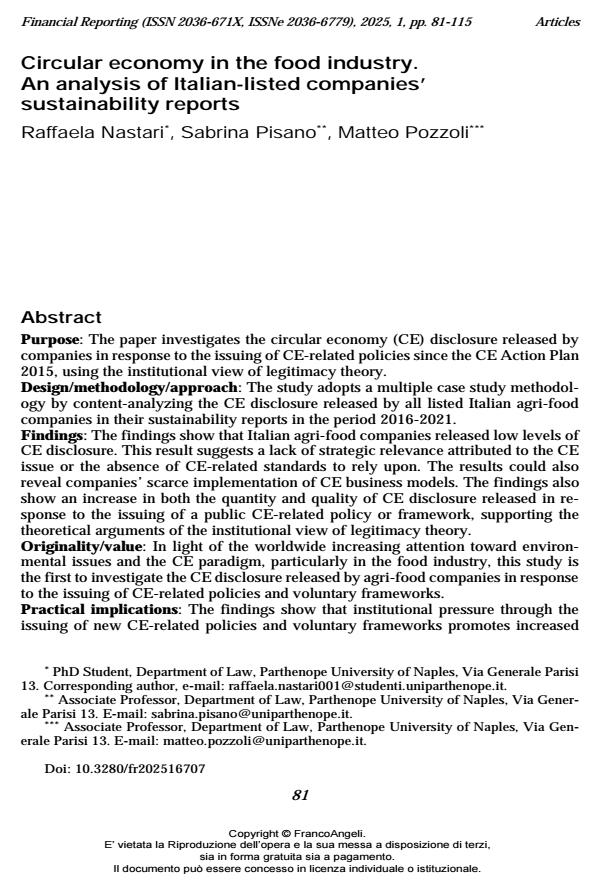Circular economy in the food industry. An analysis of Italian-listed companies’ sustainability reports
Titolo Rivista FINANCIAL REPORTING
Autori/Curatori Raffaela Nastari, Sabrina Pisano, Matteo Pozzoli
Anno di pubblicazione 2025 Fascicolo 2025/1
Lingua Inglese Numero pagine 35 P. 81-115 Dimensione file 265 KB
DOI 10.3280/fr202516707
Il DOI è il codice a barre della proprietà intellettuale: per saperne di più
clicca qui
Qui sotto puoi vedere in anteprima la prima pagina di questo articolo.
Se questo articolo ti interessa, lo puoi acquistare (e scaricare in formato pdf) seguendo le facili indicazioni per acquistare il download credit. Acquista Download Credits per scaricare questo Articolo in formato PDF

FrancoAngeli è membro della Publishers International Linking Association, Inc (PILA)associazione indipendente e non profit per facilitare (attraverso i servizi tecnologici implementati da CrossRef.org) l’accesso degli studiosi ai contenuti digitali nelle pubblicazioni professionali e scientifiche
Purpose: The paper investigates the circular economy (CE) disclosure released by companies in response to the issuing of CE-related policies since the CE Action Plan 2015, using the institutional view of legitimacy theory. Design/methodology/approach: The study adopts a multiple case study methodology by content-analyzing the CE disclosure released by all listed Italian agri-food companies in their sustainability reports in the period 2016-2021. Findings: The findings show that Italian agri-food companies released low levels of CE disclosure. This result suggests a lack of strategic relevance attributed to the CE issue or the absence of CE-related standards to rely upon. The results could also reveal companies’ scarce implementation of CE business models. The findings also show an increase in both the quantity and quality of CE disclosure released in response to the issuing of a public CE-related policy or framework, supporting the theoretical arguments of the institutional view of legitimacy theory. Originality/value: In light of the worldwide increasing attention toward environmental issues and the CE paradigm, particularly in the food industry, this study is the first to investigate the CE disclosure released by agri-food companies in response to the issuing of CE-related policies and voluntary frameworks. Practical implications: The findings show that institutional pressure through the issuing of new CE-related policies and voluntary frameworks promotes increased CE disclosure by companies, suggesting that implementing both Directive 2022/2464/EU and the EFRAG standards would further encourage the release of CE disclosure.
Parole chiave:SDG, environmental disclosure, CE Action Plan, Directive 2014/95/EU, agri-food companies, legitimacy theory
Jel codes:Q01, Q18, M41, L66, O13
Raffaela Nastari, Sabrina Pisano, Matteo Pozzoli, Circular economy in the food industry. An analysis of Italian-listed companies’ sustainability reports in "FINANCIAL REPORTING" 1/2025, pp 81-115, DOI: 10.3280/fr202516707